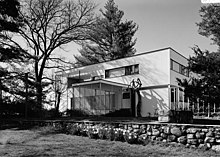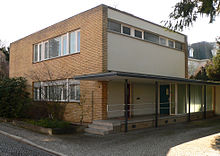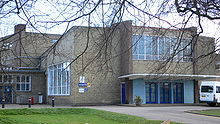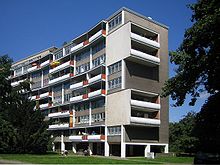Walter Gropius


Walter Adolf Georg Gropius (born May 18, 1883 in Berlin ; † July 5, 1969 in Boston , Massachusetts ) was a German (since 1944 American) architect and founder of the Bauhaus . In addition to Ludwig Mies van der Rohe , Frank Lloyd Wright and Le Corbusier , he is one of the founders of modern architecture .
family
Walter Gropius was a great-nephew of the architect Martin Gropius , a student of Karl Friedrich Schinkel , with whom Walter Gropius' grandfather, Carl Gropius, shared an apartment in Berlin as a bachelor. Walter's parents were the secret building officer Walter Gropius and Manon Scharnweber , the daughter of the Prussian politician Georg Scharnweber . In 1910 he met Alma Mahler , the wife of the composer Gustav Mahler , and began an extramarital relationship with her. In 1915 - four years after Gustav Mahler's death - they married. After their untimely death, their daughter Manon (1916–1935) was given a musical memorial by Alban Berg's violin concerto In Memory of an Angel and a literary memorial by Franz Werfel . The marriage was divorced in 1920. In 1923 Gropius married the journalist Ise , née Frank (1897–1983), who probably wrote a large part of his texts. Together they adopted Beate Forberg , called Ati , the daughter of Ise's late sister. Walter's sister Manon Burchard, nee Gropius, is the great-grandmother of the German actresses Marie Burchard and Bettina Burchard and of the art historian Wolf Burchard.
Between 1919 and 1932, the family often stayed in their villa on Strandallee in Timmendorfer Strand .
Professional career







In 1903 Gropius began studying architecture at the Technical University of Munich , which he continued at the Technical University of Berlin from 1906 , but dropped out in 1908 without a diploma . According to his own admission, he was overwhelmed with the drawing requirements in particular and was dependent on the support of helpers from an early stage. In the same year, through the mediation of Karl Ernst Osthaus, he joined the office of Peter Behrens , in which other architects who later became famous worked alongside him, including Ludwig Mies van der Rohe and Le Corbusier . At Behrens he was initially entrusted with the construction management of the Haus Cuno and Haus Schröder projects in Hagen, whose orders Osthaus had brought into the office. In retrospect, in a letter to Herta Hesse dated May 8, 1969, Gropius referred to his further role in the Behrens office as a "factotum", which, according to Nerdinger, confirms that he has other tasks due to his "inability to put even the simplest things on paper" was entrusted than with drawing. After working for Behrens for two years, Gropius started his own business as an industrial designer and architect in 1910 , but remained reliant on the support of talented employees throughout his life. In the same year he came to the German Werkbund through Karl Ernst Osthaus .
In 1912, he organized a collection of exemplary designs for factory goods for the German Museum for Art in Commerce and Industry , which Osthaus founded with the support of the Werkbund . As a designer, he designed interior fittings, wallpapers, serial furniture, car bodies and a diesel locomotive.
His first significant architectural work was the "artistic design of the shoe last factory Fagus-Werk in Alfeld an der Leine on the basis of the finished (and partly already realized) plans by Eduard Werner " (contract of May 13, 1911). This happened in the proven cooperation with Adolf Meyer . With its steel and glass architecture, this factory building is considered to be a trend-setting work of what would later become known as “ modern architecture ”, which became a general term in the 1920s under the name “ New Building ” or “ New Objectivity ”. The Fagus factory was declared a World Heritage Site by UNESCO in June 2011 .
For the exhibition of the Deutscher Werkbund in Cologne in 1914 , Gropius built a model factory together with Meyer, which would later also prove to be an important contribution to modern architecture. The peculiarity of this building were round glazed stair towers, which later, in the 1920s, were frequently used by Erich Mendelsohn in his department stores as a new design motif .
During the First World War , Gropius served as a non-commissioned officer in the reserve. He was badly wounded during his four-year service on the Western Front and was awarded the Iron Cross .
During the November Revolution of 1918, Gropius was involved in the Labor Council for Art , an association of revolutionary artists based on council democracy . The group assumed the “primacy of architecture”, called for the demolition of all war memorials and saw art as a means of revolutionizing society. From March 1919, Gropius, Adolf Behne and César Klein, had been part of their three-man management team. The group disbanded in 1921.
Gropius' involvement in another artistic movement became better known - he became the founder of the Bauhaus. In 1919, at the suggestion of Henry van de Velde, Gropius was appointed director of the Grand Ducal Saxon University of Fine Arts in Weimar ( Thuringia ) and named the new school “State Bauhaus in Weimar”. He held the office of director - initially until 1926 in Weimar, and after the relocation of the Bauhaus in Dessau (today Dessau-Roßlau in Saxony-Anhalt ). His successor in 1928 was the Swiss architect Hannes Meyer , who left in 1930 and relocated his field of activity to the Soviet Union for the next six years . Ludwig Mies van der Rohe led the Bauhaus until it was closed after the National Socialists came to power in 1933.
From 1926 Gropius worked intensively on mass housing as a solution to urban planning and social problems and advocated the rationalization of the construction industry. Among other things, he was able to fall back on the preparatory work of Martin Wagner , who had published the first suggestions for the "adoption of American rationalization methods in the German construction industry" as early as 1918. With the "Am Lindenbaum" estate (1929/1930) Gropius was also one of the architects on the New Frankfurt project . He designed numerous residential projects such as the Dessau- Törten housing estate (1926–1931) with Leopold Fischer , Dammerstock (1928/1929), apartment blocks in Siemensstadt in Berlin (1929/1930) and the Wannsee bank development project , also in Berlin (1930 / 1931).
In 1927 Walter Gropius was co-founder of the total theater project with Erwin Piscator , which aimed to remove the spatial separation between actors and spectators. From 1928 he worked as a freelance architect in Berlin. Marianne Brandt worked briefly in 1929 as an interior designer in his office. In 1930, together with other “Bauhaus members”, he organized the state-sponsored Werkbund exhibition on the subject of “The Apartment” in Paris. Walter Gropius worked with Hanns Dustmann from 1929 to 1933 .
After the National Socialists attacked the Bauhaus in 1934 as the “Church of Marxism ”, Gropius emigrated to London . There he worked in partnership with Maxwell Fry and lived like Marcel Breuer , László Moholy-Nagy , Arthur Korn and Agatha Christie in the Isokon Flats of Wells Coates . In 1937 he went to Cambridge in the USA , where he was professor of architecture at the Graduate School of Design at Harvard University . In 1938 he moved into his newly built residential building in Lincoln, Massachusetts , now under the name Gropius House as a National Historic Landmark in the National Register of Historic Places entered and open to the public as a museum.
From 1941 to 1948 Gropius worked closely with Konrad Wachsmann , who was led by Dr. Estrich and the Einsteinhaus Caputh began his career as a freelance architect. Among other things, they developed and produced the well-known general panel system .
In 1946 Gropius founded the group The Architects Collaborative, Inc. (TAC) as an association of young architects, which for him should also become a manifesto of his belief in the importance of teamwork. One of the works of this team is the Graduate Center at Harvard University in Cambridge (1949/1950). His book Architecture - Paths to an Optical Culture is a plea for creativity and teamwork in the service of society.
In the last years of his life, Gropius was again frequently active in Berlin , where, among other things, he built a nine-story apartment block in the Hansaviertel in 1957 as part of Interbau . The concave south front and the open ground floor are typical examples of “late modernism” in this building.
On October 2, 1955, Gropius spoke at the opening of the Ulm School of Design : “And if the political development of the time is more stable than during the Bauhaus era, then the artistic charisma of the School of Design can go beyond the borders of Ulm and Germany and convince the world of the necessity and importance of the artistic person for the thriving of genuine progressive democracy. "
In the early 1960s, Gropius campaigned for the preservation of the former Kunstgewerbemuseum Berlin , which his great-uncle Martin Gropius had designed. The building was listed as a historical monument in 1966. He did not experience the later reconstruction up to the new use.
rating
Not all of Gropius' works were undisputed. Critics complained that he sometimes went too far in his endeavors to industrialize and standardize building: it was not the needs of the residents that determined the floor plans, but the course of the construction cranes; Bathtubs would be placed between the sink and stove; Windows could not be opened fully; The Kupferhaussiedlung in Finow, for example, is neither aesthetically nor functionally appealing.
Gropius laid the foundation for the prefabricated buildings in the satellite cities with his idea of the “large-scale construction kit” . On the one hand, industrial mass production made it possible to provide urgently needed living space; on the other, it made living anonymous and created new social problems. Theodor W. Adorno criticized the formalism of the Bauhaus style in his essay Asylum for the homeless .
In his contribution Bilde Künstler, do not speak , published in 1953 in the architecture magazine Baukunst und Werkform , Rudolf Schwarz questioned the mechanical functionalism of the Bauhaus style. This led to an open discussion with Walter Gropius and prompted the so-called Bauhaus debate in West Germany.
Memberships
- 1910: Member of the German Werkbund
- 1918: Member of the "Labor Council for Art"
- 1928: Founding member of CIAM
- 1944: Elected to the American Academy of Arts and Sciences
- 1962 Elected member of the American Academy of Arts and Letters
- 1968: Elected member (NA) of the National Academy in New York
- 1968: Appointment as honorary member of the State Academy of Fine Arts Stuttgart
Honors
- In 1929 he was awarded an honorary doctorate from the Technical University of Hanover and later, among others, from the Free University of Berlin (1963).
- 1958: Large Cross of Merit with Star of the Federal Republic of Germany
- 1956: Hansian Goethe Prize .
- 1959: AIA Gold Medal from the American Institute of Architects
- 1999: An asteroid of the inner main belt was named after him: (9577) Gropius .
Works (selection)
- Fagus factory , Alfeld , 1st construction phase 1911/1912, 2nd construction phase 1913/1914, additions until 1925, UNESCO World Heritage
- Housing estate “Eigen Scholle”, Wittenberge , 1914
- Memorial to those who fell in March , Weimar , 1920–1922
- Sommerfeld House , Berlin-Dahlem , 1921
- Jena City Theater , 1922
- Factory building of the agricultural machinery factory Gebr .kap & Co., Alfeld, 1922–1924
- Residence for Felix Auerbach , Jena, 1924
- Friedrich-Froebel-Haus , Bad Liebenstein , 1924, not executed
- AMCO factory expansion building , Kirchbrak , 1925
- Bauhaus Dessau , main building, 1925/1926
- Bauhaus Dessau, “Meisterhäuser” (houses of the Bauhaus teachers), 1925/1926
- Dessau- Törten settlement , 1926–1928
- Competition city hall, museum and sports forum Halle (Saale) , 1927–1928, not carried out
- Employment Office Dessau , Dessau , 1927–1929
- Two houses in the Weißenhofsiedlung , Stuttgart , 1927
- Residence for Therese Zuckerkandl, widow of Robert Zuckerkandl , Jena, 1927–1929
- Lewin House, Berlin, Fischerhüttenstr. 106, 1928-1929
- Dammerstock settlement , Karlsruhe , 1928/1929
- Settlement “Am Lindenbaum” as part of the Neues Frankfurt project , Frankfurt, 1929–1930
- Siemensstadt housing estate , Berlin, 1929–1930
- Type houses for the copper house project of the Hirsch Kupfer- und Messingwerke , Finow , 1931/32
- Gropius House , Lincoln ( Massachusetts ), 1937
- Packaged House System together with Konrad Wachsmann , Lincoln (Massachusetts), 1941–1943
- Harvard University Graduate Center as TAC's first project, 1948–1950
- Stichweh house , Alleehof 4, Hanover , 1952/1953
- University of Baghdad , as a further project of the TAC, 1957
- Interbau in the Hansaviertel in Berlin, nine-storey residential building 1957
- Pan Am Skyscraper in Manhattan , 1957–1959
- Temple Oheb Shalom Synagogue , Baltimore , 1960
- Gropiusstadt in what was then West Berlin , from 1960 (the planning was later modified)
- US Embassy in Athens , 1956–1961
- Porcelain factory Rosenthal am Rotbühl, Selb , 1965
- "Glass Cathedral" (formerly Thomas Glaswerk ), Amberg , planned in 1967, completed in 1970
- Bauhaus Archive Berlin, TAC ( Alexander Cvijanovic , revision of the draft for an archive in Darmstadt), 1977–1979
- Porto Carras , hotel complex on the peninsula Chalkidiki , posthumously built
- TAC teapot for Rosenthal , 1969

Fonts (selection)
- Idea and structure of the state Bauhaus. Bauhaus Verlag, Weimar, Munich 1923, 12 pp.
- International architecture. A. Langen, Munich 1925, 106 pages (= Bauhaus books 1), new edition: Gebrüder Mann, Berlin 1981, ISBN 3-7861-1477-3 .
- Architecture - ways to an optical culture . Fischer library, Frankfurt / M = Hamburg 1956.
- Selected Writings. Ernst, Publishing House for Architecture and Technical Sciences, Berlin 1988.
Secondary literature (chronological selection)
- Adolf Behne : designs and buildings by Walter Gropius . In: Zentralblatt der Bauverwaltung , Volume 42, No. 104 (December 27, 1922), pp. 637–640.
- Reginald R. Isaacs: Walter Gropius. Man and his work. Gebrüder Mann, Berlin 1983, ISBN 3-7861-1372-6 , also published as a paperback by Ullstein.
- Karin Wilhelm: Walter Gropius. Industrial architect, Braunschweig 1983. ISBN 3-528-08690-4 .
- Winfried Nerdinger : The architect Walter Gropius. Bauhaus Archive Berlin, Gebr. Mann Verlag 1985, 1996, ISBN 3-7861-1844-2 .
- Horst Claussen: Walter Gropius. Outlines of his thinking. Olms, Hildesheim [u. a.] 1986, ISBN 3-487-07730-2 .
- Ulrich Conrads ... (Ed.): The Bauhaus Debate 1953, documents of a repressed controversy. Braunschweig, Wiesbaden: Vieweg 1994, ISBN 3-528-06100-6 .
- Ulrich Müller: Space, Movement and Time in the Work of Walter Gropius and Ludwig Mies van der Rohe. Akademie-Verlag, Berlin 2004, ISBN 3-05-004059-9 .
- Nicholas Fox Weber: The Bauhaus group: six masters of modernism. Knopf, New York 2009, ISBN 0-307-26836-5 .
- Nicolette Baumeister: Construction documentation 02 - Glaswerk, Amberg. Koch, Schmidt u. Wilhelm 2015.
- Jan Pieper, Das Fagus-Werk, principles and elements of historical architecture in the founding building of the modern age, Geymüller Verlag für Architektur, Aachen 2016, ISBN 978-3-943164-11-4 .
- Marcel Bois: Art and Architecture for a New Society. Russian avant-garde, Labor Council for Art and the Viennese Settler Movement in the Interwar Period , in: Work - Movement - History , Issue III / 2017, pp. 12–34.
- Bernd Polster : Walter Gropius. The architect of his fame . Hanser, Munich 2019, ISBN 978-3-446-26263-8 .
- Nicolette Baumeister: Baukultur Guide 118 - Rosenthal am Rothbühl, Selbe. Koch, Schmidt u. Wilhelm 2019.
- Carsten Krohn: Walter Gropius. Buildings and projects , Basel: Birkhäuser 2019, ISBN 978-3-0356-1727-6 .
- Winfried Nerdinger: Walter Gropius: Architekt der Moderne , Munich: Verlag CH Beck 2019, ISBN 978-3-406-74132-6 .
- Bettina Güldner: Walter Gropius. Architect, visionary, teacher , Wiesbaden: Weimarer Verlagsgesellschaft 2019, ISBN 9783737402729 .
Fiction
- Theresia Enzensberger : Blueprint. Hanser, Munich 2017, ISBN 978-3-446-25643-9 . Walter Gropius as a realistic fictional character.
Representation in the film
Walter Gropius has been portrayed several times in cinema and television films.
- 2001 Die Windsbraut , played by Simon Verhoeven
- 2010 Mahler on the couch , played by Friedrich Mücke
- 2018 Lotte at the Bauhaus , played by Jörg Hartmann
- 2019 Die neue Zeit , played by August Diehl
Web links
- Literature by and about Walter Gropius in the catalog of the German National Library
- Works by and about Walter Gropius in the German Digital Library
- Newspaper article about Walter Gropius in the 20th century press kit of the ZBW - Leibniz Information Center for Economics .
- The calendar sheet April 12, 1919 - The Bauhaus is founded
- Image index with numerous images of Gropius works (the question of copyright is currently unresolved)
- Thilo Kuner, Janca Imwolde: Walter Gropius. Tabular curriculum vitae in the LeMO ( DHM and HdG )
- Representation of the architecture by Walter Gropius using the example of the Rosenthal porcelain factory in Selb ( Memento from May 21, 2006 in the Internet Archive )
- Gropius buildings in Dessau
- Gropius pusher
- Bauhaus Archive Museum für Gestaltung Berlin, about the Bauhaus 1919–1933
- Gropius in Karlsruhe's Dammerstock in Classic Modern Baden-Württemberg
- House Stichweh in Hanover
- Anne-Solène Rolland, Helene Greubel (ex.): Gropius, Le Corbusier and Mies van der Rohe . ( Memento of December 4, 2011 in the Internet Archive ) Rencontres , September 1, 2006.
- Wolfgang Thöner: The talented Mister Bauhaus , in: Einestages , Spiegel Online (with pictures)
- http://www.deutschlandradiokultur.de/das-gropius-prinzip.984.de.html?dram:article_id=153419
- Design classics overview and biography of Walter Gropius on edition20 (with pictures)
Individual evidence
- ^ Reginald R. Isaacs: Reginald R. Isaacs: Walter Gropius. Man and his work . Mann Brothers, Berlin 1983.
- ↑ Ulrike Müller: Bauhaus women. Masters in art, craft and design. Munich: Sandmann 2009. ISBN 978-3-938045-36-7 .
- ↑ German Gender Book . tape 3 . Strong publisher, 1972.
- ^ Exhibition Bauhaus in Timmendorfer Strand
- ^ C. Arthur Croyle: Hertwig: The Zelig of Design. (Teaser). ( Memento of June 6, 2014 in the Internet Archive ) (PDF; 9.3 MB) Culicidae Press, 2011, ISBN 978-0-557-72969-2 , p. 102.
- ↑ a b Welf Grombacher: Father of modern building. Article in the Märkische Oderzeitung, Frankfurter Stadtbote , 17./18. May 2008, p. 8. 1907
- ^ A b Nerdinger, Winfried: The architect Walter Gropius: drawings, plans, photos, catalog raisonné. Berlin 1985, p. 29
- ^ Hesse-Frielinghaus, Herta (Ed.): KE Osthaus, life and work. Recklinghausen 1971, p. 459
- ^ Nerdinger, Winfried: The architect Walter Gropius: drawings, plans, photos, catalog raisonné. Berlin 1985, pp. 29-32
- ↑ cf. Joan Campbell: The German Werkbund, 1907-1934. Munich 1989, p. 50.
- ↑ Bernd Polster: Walter Gropius. The architect of his fame , p. 160 ff
- ^ Marcel Bois: Art and Architecture for a New Society. Russian avant-garde, labor council for art and the Viennese settler movement in the interwar period. In: Work - Movement - History, Volume III / 2017, pp. 12–34, especially p. 23.
- ^ Nerdinger, Winfried: The architect Walter Gropius: drawings, plans, photos, catalog raisonné. Berlin 1985, p. 12
- ^ Deutscher Werkbund NW: 1930: The exhibition in Paris ( Memento from June 17, 2016 in the Internet Archive ).
- ^ Hanns Dustmann Diebrock, Westphalia, Germany 1902 - 1979 Dusseldorf, Germany. In: Harvard Art Museums. Retrieved October 4, 2019 .
- ↑ Gerhard Richter: Ulm School of Design. End of an intellectual awakening. In: Deutschlandradio DLF. August 1, 2018, accessed October 4, 2019 .
- ^ Theodor W. Adorno: Minima Moralia. Frankfurt 1951, ISBN 3-518-41300-7 , pp. 55f.
- ^ Adolf Stock: The Gropius Principle - How an architect invented the Bauhaus trademark. Deutschlandradio Kultur, May 14, 2008, accessed on March 22, 2018 .
- ^ Khan, Uddin-Hasan: Weltarchitektur - International Style, Architektur der Moderne from 1925-1965 . Ed .: Philip Jodido. Taschen Verlag GmbH, Cologne 2009, ISBN 978-3-8365-1050-9 , pp. 34 .
- ^ Members of the American Academy. Listed by election year, 1900-1949 ( PDF ). Retrieved October 8, 2015
- ^ Members: Walter Gropius. American Academy of Arts and Letters, accessed April 1, 2019 .
- ^ Past Academicians "G" ( Memento from January 16, 2014 in the Internet Archive ), nationalacademy.org, accessed on March 13, 2015
- ^ "Biography of Walter Gropius" . Research project architecture and engineering in the 1950s, 60s and 70s in North Rhine-Westphalia, TU Dortmund. Retrieved January 31, 2010.
- ↑ visit-jena.de
- ^ Barbara Happe / Martin S. Fischer: Haus Auerbach by Walter Gropius with Adolf Meyer , Berlin: jovis 2018, ISBN 978-3-86859-564-2 .
- ↑ It's best to build in the spirit in: FAZ of August 20, 2011, p. 32
- ↑ Helmut Knocke , Hugo Thielen : Alleehof 4 , in: Hannover Art and Culture Lexicon , p. 75f.
- ↑ The master returns in FAZ of August 24, 2013, p. 35
- ↑ bauhaus-shop.de: TAC teapot
- ↑ rosenthal.de: TAC - Rosenthal studio-line: Service classics in the Bauhaus style
| personal data | |
|---|---|
| SURNAME | Gropius, Walter |
| ALTERNATIVE NAMES | Gropius, Walter Adolf Georg (full name) |
| BRIEF DESCRIPTION | German architect and founder of the Bauhaus |
| DATE OF BIRTH | May 18, 1883 |
| PLACE OF BIRTH | Berlin |
| DATE OF DEATH | 5th July 1969 |
| Place of death | Boston , Massachusetts |




